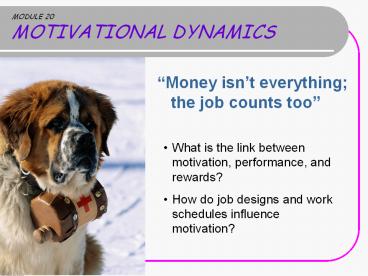MODULE 20 MOTIVATIONAL DYNAMICS PowerPoint PPT Presentation
Title: MODULE 20 MOTIVATIONAL DYNAMICS
1
MODULE 20MOTIVATIONAL DYNAMICS
- Money isnt everything the job counts too
- What is the link between motivation, performance,
and rewards? - How do job designs and work schedules influence
motivation?
2
MOTIVATIONAL DYNAMICS Motivation, Performance
and RewardsMODULE GUIDE 20.1
- Motivation is influenced by both extrinsic and
intrinsic rewards. - Merit pay has pros and cons as a
pay-for-performance system. - Bonuses and profit sharing plans link pay with
performance. - Employee stock ownership ties financial rewards
to firm performance.
3
MOTIVATIONAL DYNAMICS Motivation, Performance
and Rewards
4
MOTIVATIONAL DYNAMICS Motivation, Performance
and Rewards
- Extrinsic Reward
- is provided by someone else.
- Intrinsic Reward
- occurs naturally during job performance.
- Performance-contingent Reward
- is linked directly to job performance.
5
MOTIVATIONAL DYNAMICS Motivation, Performance
and Rewards
- Merit Pay
- awards pay increases in proportion to performance
contributions. - Bonus Pay
- provides one-time payments based on performance
accomplishments. - Profit Sharing
- distributes to employees a proportion of net
profits earned by the organization. - Gain Sharing
- allows employees to share in cost savings or
productivity gains realized by their efforts. - Stock Options
- give the right to purchase shares at a fixed
price in the future.
6
MOTIVATIONAL DYNAMICS Job Designs and Work
SchedulesMODULE 20.2
- Job simplification builds narrow, routine, and
repetitive jobs. - Job rotation and job enlargement increase task
variety in job content. - Job enrichment expands job content with
self-management responsibilities. - Self-managing teams are a form of job enrichment
for groups. - Alternative work schedules offer flexibility in
job context. - Contingency and part-time work have pluses and
minuses.
7
MOTIVATIONAL DYNAMICS Job Designs and Work
Schedules
8
MOTIVATIONAL DYNAMICS Job Designs and Work
Schedules
- Job Design
- is the allocation of specific work tasks to
individuals and groups.
9
MOTIVATIONAL DYNAMICS Job Designs and Work
Schedules
- Job Simplification
- employs people in clearly defined and very
specialized tasks. - Job Rotation
- increases task variety by periodically shifting
workers between different jobs. - Job Enlargement
- allows individuals to perform a broader range of
tasks job rotation allows individuals to shift
among different jobs of similar skill levels. - Self Managing Teams
- Make many decisions about how they do their work
10
MOTIVATIONAL DYNAMICS Job Designs and Work
Schedules
11
MOTIVATIONAL DYNAMICS Job Designs and Work
Schedules
- Alternative Work Schedules
- Compressed Workweek
- allows a worker to complete a full-time job in
less than the standard five days of 8-hour shifts - Flextime
- describes any work schedule that gives employees
some choice in daily work hours. - Job Sharing
- two or more persons split one full-time job.
- Telecommuting
- involves using IT to work at home or outside the
office.
12
MOTIVATIONAL DYNAMICS Job Designs and Work
Schedules
- Contingency and Part-Time Work
- Part-time Work
- is temporary employment for less than the
standard 40-hour workweek. - Contingency Workers
- are employed on a part-time and temporary basis
to supplement a permanent workforce.
13
MOTIVATIONAL DYNAMICS Job Designs and Work
Schedules
- MANAGEMENT TIPS
- How to make telecommuting work for you
- Treat telecommuting like any workday keep
regular hours. - Limit nonwork distractions set up private
space dedicated to work. - Establish positive routines and work habits be
disciplined. - Report regularly to your boss and main office
dont lose touch. - Seek out human contact dont become isolated.
- Use technology instant messaging, intranet
links, Net meetings. - Keep your freedoms and responsibilities in
balance. - Reward yourself with time off let flexibility
be an advantage.
14
MOTIVATIONAL DYNAMICS Job Designs and Work
Schedules
- Work schedule trends and preferences
- Flextime ranks 1 in desired job supports.
- 12 of U.S. workers do some remote work.
- 70 of Agilents workers are remote at least
some of the time. - 33 of women and 28 of men would like
part-time work if they could afford it. - 58 of retiring baby boomers would like to work
part-time.

